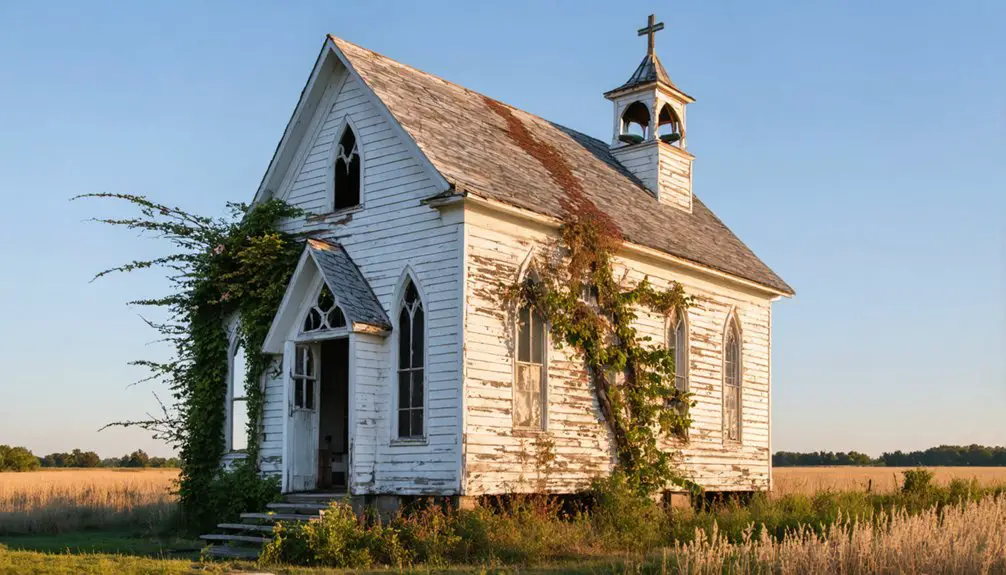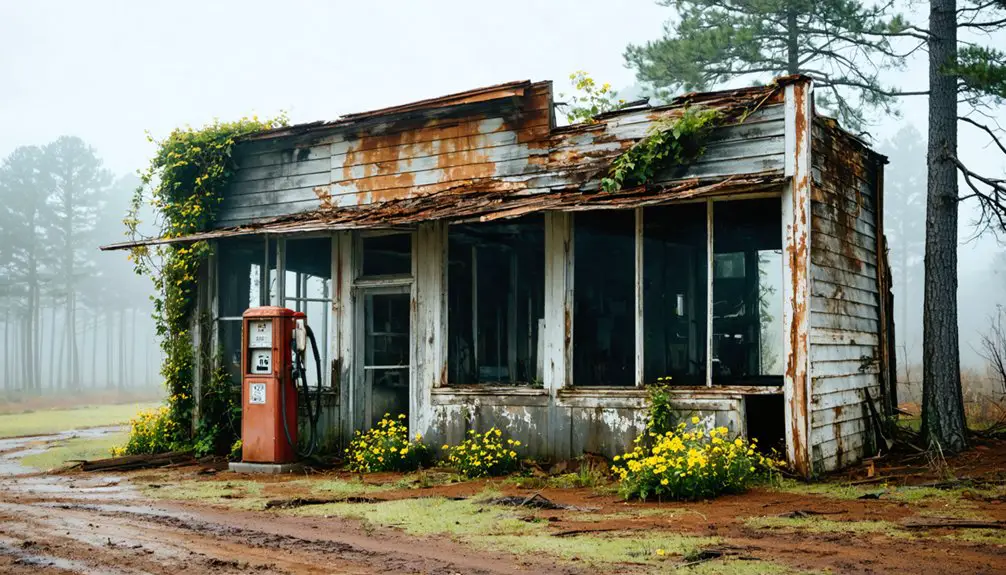You’ll find Bankston’s haunting ruins in Choctaw County, Mississippi, where Colonel James M. Wesson established the state’s first cotton mill village in 1847. The industrial powerhouse produced 1,000 yards of cloth daily for Confederate forces until Union troops destroyed it on December 30, 1864. After the raid, the population dwindled to just 84 residents by 1900. Today, abandoned industrial remnants and the old Bankston cemetery tell a deeper story of Mississippi’s Civil War manufacturing legacy.
Key Takeaways
- Bankston, Mississippi was founded in 1847 as a cotton mill village but became a ghost town after Union forces destroyed its mills in 1864.
- The town’s population declined dramatically from its industrial peak to just 84 residents by 1900, following the destruction of its manufacturing base.
- The closure of Bankston’s post office in 1905 marked the final chapter in its transformation from thriving industrial center to abandoned ghost town.
- Historical ruins, including the old Bankston cemetery, now serve as tourist attractions showcasing the town’s Civil War and industrial heritage.
- The site remains accessible via 2WD routes, allowing visitors to explore the remnants of Mississippi’s first mechanized textile manufacturing center.
The Birth of a Southern Industrial Hub
While most of antebellum Mississippi remained firmly agricultural, Bankston emerged in 1847 as a pioneering industrial settlement when Colonel James M. Wesson and his associates established the Mississippi Manufacturing Company.
Their industrial innovation began with a strategic location on McCurtains Creek in Choctaw County, deliberately positioning the textile production facility away from established towns to maintain worker focus.
You’ll find that Bankston wasn’t just another mill town – it was Mississippi’s first cotton mill village, marking a significant shift toward Southern industrialization.
By December 1848, the mill started operations with twelve workers, setting new standards for controlled social conditions. The facility rapidly expanded to include 500 cotton spindles, producing an impressive 300 pounds of yarn daily.
The modest launch of twelve workers in December 1848 marked the beginning of a revolutionary shift in Mississippi’s industrial landscape.
The company banned whiskey and promoted religious instruction, creating a model company town that would shape the future of industrial development in the Old Southwest. Much like other early Mississippi textile operations, the mill employed primarily white workers to operate its machinery.
Confederate Supply Chain Powerhouse
During the Civil War, Bankston emerged as a critical Confederate manufacturing hub, producing an impressive 1,000 yards of cloth and 150 pairs of shoes daily for Southern forces.
The town’s industrial innovation centered on its powerful Semple steam engine, which drove multiple production lines for textiles, flour, and leather goods.
You’ll find Bankston’s supply logistics were particularly remarkable. Its location in Choctaw County provided natural protection from Union raids, allowing it to operate longer than other Mississippi mills.
The facility carried forward the legacy of the hand spinning and weaving traditions that dominated textile production before mechanization arrived in Mississippi.
Originally established in 1847 by Colonel James M. Wesson and his partners, the Mississippi Manufacturing Company became a model of wartime industrial efficiency.
The Mississippi Manufacturing Company remained the state’s last operational woolen mill, supporting Confederate troops until late 1864.
When Federal forces finally approached, workers distributed remaining supplies to civilians before General Grierson’s raiders destroyed the facilities on December 30, marking the end of Bankston’s role as a Confederate industrial powerhouse.
Life in Antebellum Bankston
Before its wartime prominence, Bankston made history as Mississippi’s first successful cotton mill village, established in 1848 by James M. Wesson and his associates.
You’d find about 100 workers operating 1,000 cotton spindles, 500 wool spindles, and 20 power looms at the height of textile production in the 1850s.
Life in this antebellum company town centered around strict community dynamics.
The rigid social structure of antebellum mill villages shaped every aspect of daily life for their industrial workers.
If you’d lived there, you’d have experienced management’s tight control over daily activities, including bans on whiskey sales and mandatory religious instruction.
The workforce, primarily white laborers, lived in company-provided housing within the planned mill village.
While a few slaves operated the steam engine, mill owners found white labor more economical for industrial work.
During this period, most Mississippi investors focused on land and slaves rather than industrial development.
The mill kept detailed daily records of production output and worker activities, similar to other antebellum plantations of the era.
James Madison Wesson’s Vision
Through his ambitious vision of industrial modernization, James Madison Wesson transformed Mississippi’s economic landscape when he established the state’s first successful mechanized cotton mill in Bankston in 1848.
His industrial vision centered on creating a self-sustaining manufacturing town that would merge agricultural resources with mechanized innovation, producing essential textiles and footwear.
You’ll find evidence of his forward thinking in the mill’s impressive daily output of 1,000 yards of cloth and 150 pairs of shoes, which later proved vital for Confederate supplies during the Civil War.
The Mississippi Manufacturing Company became the economic backbone of the growing community, providing stable employment and fostering local industry.
Wesson’s determination to modernize the South’s traditionally agrarian economy through vertical integration and technological advancement laid the groundwork for a new economic model.
His approach emphasized building thriving industrial communities that could support local prosperity while pioneering mechanized production methods.
A devastating fire in 1871 destroyed the original manufacturing company, leading Wesson to partner with new investors to rebuild and establish Mississippi Mills.
The Fatal Night of December 30, 1864
As Union forces under General Benjamin H. Grierson approached Bankston on the night of December 30, 1864, they found a sleeping town unaware of its impending fate.
In this crucial moment of Bankston history, Union raiders struck without firing a shot, systematically burning the town’s essential Confederate supply centers. The raid was part of Grierson’s larger mission to disrupt supply lines along the Mobile and Ohio Railroad. After completing their destructive mission, eleven Union soldiers stayed at the Bankston Hotel.
You would’ve witnessed the destruction of mills producing 1,000 yards of cloth daily, a shoe factory crafting 150 pairs for Southern troops, and stockpiles of wool, cotton, and flour going up in flames.
The Civil War significance of this raid was immediate – Bankston’s last operational textile mill in Mississippi fell silent that night.
When Bankston’s final mill fell to Union forces, Mississippi lost its last thread of textile production for the Confederacy.
While Colonel Wesson had managed to distribute some supplies beforehand, the raid effectively ended Bankston’s role as a Confederate industrial hub.
Union Raid and Industrial Destruction
Under cover of darkness on December 30, 1864, Colonel Benjamin H. Grierson’s Union cavalry executed a precise night raid on Bankston’s industrial heart while residents slept.
Union forces moved silently through swamps and muddy roads, strategically targeting the town’s essential manufacturing facilities without firing a single shot.
The raiders destroyed Bankston’s economic backbone in one devastating sweep, burning the cotton and wool mill, shoe factory, and flour mill that had been producing 1,000 yards of cloth and 150 pairs of shoes daily for Confederate forces.
Strategic Timing of Attack
When Union forces struck Bankston on December 30, 1864, they seized a critical moment late in the Civil War to cripple Confederate resources in northern Mississippi. The raid’s strategic advantages were clear – Bankston’s mills produced 1,000 yards of cloth and 150 pairs of shoes daily for Confederate troops. The timing couldn’t have been more devastating, disrupting winter supply production when Confederate needs peaked.
Using surprise tactics under cover of darkness, Union raiders destroyed the settlement’s industrial heart: cotton and wool mills, shoe factories, and flour mills. They burned 5,000 yards of cloth, 10,000 pounds of wool, and 125 bales of cotton.
The attack’s timing, following the Battle of Egypt Station, was part of a broader campaign to destroy Confederate infrastructure and accelerate the South’s inevitable collapse.
Union Forces’ Tactical Approach
Three distinct tactics defined the Union forces’ approach to raiding Bankston.
You’ll find that tactical deception played a vital role, as Union forces sent smaller units ahead to confuse Confederate defenders about their main force’s location. Through cavalry mobility, Colonel Grierson’s troops covered over 600 miles of enemy territory, striking deep into Confederate logistics while avoiding major confrontations.
- Systematic destruction of railroads, including tearing up tracks and burning crossties across 50-60 miles
- Strategic targeting of bridges, trestles, and weapon depots to cripple supply chains
- Use of breech-loading weapons for increased combat effectiveness
- Employment of captured Confederate uniforms for enhanced intelligence gathering
The raid’s success stemmed from its integration within Grant’s larger Vicksburg Campaign, effectively isolating Confederate forces and disrupting their ability to coordinate defenses.
Complete Factory Annihilation
The Union’s tactical prowess culminated in the devastating December 30, 1864 raid on Bankston’s industrial heart.
Under cover of darkness, eleven of Grierson’s cavalry troops systematically destroyed the town’s industrial significance, setting ablaze the cotton mill, woolen mill, flour mill, shoe factory, tannery, and machine shop that had been essential to Confederate supply lines.
The destruction was absolute and precise.
You’d have witnessed these facilities, which once produced 1,000 yards of cloth and 150 pairs of shoes daily, reduced to ashes in a single night.
The economic collapse that followed was swift and irreversible.
James Madison Wesson, the original mill owner, abandoned the ruins and relocated to establish new operations elsewhere, while Bankston’s population dwindled to just 84 residents by 1900.
Aftermath and Population Exodus
The destruction of Bankston’s factories in 1864 eliminated the town’s core economic engine, leaving residents without stable employment or income.
You’ll find that many citizens, following mill owner James Madison Wesson’s example, relocated to other Mississippi towns with more promising opportunities, particularly to the newly established town of Wesson.
The town’s population dwindled to just 84 residents by 1900, and attempts to rebuild the industrial base proved futile as subsequent facilities were also targeted for destruction.
Economic Devastation Takes Hold
Devastating economic collapse struck Bankston after Union troops strategically destroyed the town’s industrial backbone on December 30, 1864. The fires that consumed the cotton factory, wool mill, flour mill, and shoe factory triggered immediate economic despair throughout the community.
You’d witness the swift disintegration of Bankston’s once-thriving industrial center, which had produced 1,000 yards of cloth and 150 pairs of shoes daily.
- 85 workers instantly lost their livelihoods, leading to widespread unemployment
- Mill owner James Madison Wesson relocated operations to Wesson, Mississippi
- Loss of manufacturing eliminated critical goods production for local residents
- Without diversified industries, the town couldn’t recover from the destruction
The community’s isolation and lack of rail connections prevented any meaningful reconstruction efforts, sealing Bankston’s fate as an emerging ghost town.
Residents Seek New Opportunities
Following the destruction of Bankston’s industrial core in 1864, residents faced an urgent choice between staying in their deteriorating town or seeking opportunities elsewhere. Most chose to leave, sparking a massive population migration that reduced Bankston to just 84 inhabitants by 1900.
You’ll find that former residents primarily moved to neighboring towns and counties where economic opportunities still existed. Many joined the growing urban centers across Mississippi, following patterns similar to other declining rural communities of that era.
While some families attempted to maintain their connection to Bankston through the local cemetery and occasional visits, the lack of employment and infrastructure made permanent resettlement impossible. The town’s remaining commercial establishments, schools, and churches eventually collapsed, leaving only historical records and gravestones to tell Bankston’s story.
Lost Industry Never Returns
As Union troops torched Bankston’s industrial heart on December 30, 1864, they effectively sealed the town’s economic fate.
You’ll find no industrial revival here – the destruction of 1,000 cotton spindles, 500 wool spindles, and 20 power looms marked the end of Mississippi’s first successful mechanized textile operation.
Despite the region’s economic resilience elsewhere, Bankston’s manufacturing prowess never returned.
- James Madison Wesson relocated his expertise to nearby Wesson, taking essential leadership with him
- Failed attempts to rebuild ended when a new factory burned, crushing hopes of recovery
- Population plummeted to just 84 residents by 1900 as workers sought opportunities elsewhere
- The post office’s closure in 1905 symbolized the final blow to Bankston’s industrial dreams
What Remains Today
While Bankston once thrived as a bustling Mississippi town, today it stands practically abandoned with only sparse remnants of its former existence.
If you visit, you’ll find the Bankston Cemetery serves as the primary historical marker, standing as a silent symbol of the community that once called this place home. Near the cemetery, you can spot remnants of an old store, though most of the town has surrendered to nature’s reclamation.
The cemetery’s significance extends beyond its role as a burial ground – it’s now the most tangible link to Bankston’s past.
Archaeological challenges stem from the Civil War’s destructive impact and decades of abandonment, leaving researchers with limited physical evidence to study. The site’s overgrown condition and isolation reflect its transformation from a vibrant town to a quiet ghost of Mississippi history.
Legacy in Mississippi’s Civil War History
You’ll find Bankston’s most enduring legacy in its role as an essential Confederate supply hub, where its mills produced 1,000 yards of cloth and 150 pairs of shoes daily for Southern forces.
The Union raid’s deliberate destruction of Bankston’s manufacturing facilities on December 30, 1864, which included burning 5,000 yards of cloth and 10,000 pounds of wool, marked a strategic blow to Confederate logistics in Mississippi.
The town’s eventual decline into a ghost town serves as a stark reminder of how the Civil War’s targeted destruction of industrial capacity could permanently alter a community’s trajectory.
Confederate Supply Hub Impact
During the Civil War, Bankston’s textile mill played a pivotal role in sustaining Confederate forces through its production of essential military supplies.
You’ll find this pioneering facility was Mississippi’s first successful mechanized cloth manufacturer, operating until late 1864 when Union forces finally destroyed it. The mill’s strategic location near the Big Black River enabled safe transport of supplies throughout Mississippi, while its textile production helped maintain Confederate quartermaster operations after the fall of major industrial centers.
- Supplied uniforms for the Army of Tennessee and other Western Confederate forces
- Operated longer than most Southern factories due to its remote Choctaw County location
- Formed part of an integral network of small textile facilities in the Lower South
- Helped delay Confederate supply disruption in Mississippi until Grierson’s raid in 1864
Union Raid’s Lasting Effects
The Union raid on Bankston and surrounding areas in 1864 marked a definitive shift in Mississippi’s Civil War trajectory.
You’ll find that this operation showcased revolutionary Union tactics, as cavalry units struck deep behind Confederate lines, destroying essential infrastructure and supplies that sustained Southern resistance in the region.
The raid’s lasting impact went beyond physical destruction. It demonstrated the effectiveness of new cavalry innovation, where mounted forces could operate independently for extended periods while wreaking havoc on enemy territory.
In Bankston and nearby communities, the raid’s psychological effects lingered long after the war, as it proved the Confederacy couldn’t protect its interior regions.
The operation’s success influenced future military doctrine and contributed greatly to the Union’s eventual victory in Mississippi.
Historical Tourism and Ghost Town Appeal
While many ghost towns offer glimpses into America’s past, Bankston’s unique Civil War heritage and industrial ruins make it a compelling destination for historical tourism enthusiasts.
Step back in time at Bankston, where Civil War relics and industrial remnants create an authentic window into America’s storied past.
You’ll find a site where historical significance meets raw authenticity, with the town’s abandoned grounds and cemetery telling stories of its industrial might and eventual downfall. The tourism potential lies in its untouched, genuine state.
- The old Bankston cemetery serves as the central attraction, offering insights into 19th-century burial practices
- Year-round accessibility via 2WD routes makes exploration convenient in all seasons
- The site of former Confederate supply factories provides a tangible connection to Civil War history
- Limited modern development preserves the authentic ghost town atmosphere visitors seek
Frequently Asked Questions
What Happened to James Madison Wesson’s Family After Leaving Bankston?
You’ll find that the Wesson legacy flourished after they moved to Wesson, Mississippi, where they established successful textile mills, gained industrial prominence, and left a lasting family history through multiple generations.
Were Any Artifacts From the Original Factories Ever Recovered?
You’ll find the trail’s gone cold on artifact preservation – there’s no documented recovery of factory remnants. Though specialized machinery once hummed there, no physical pieces are known to survive today.
How Many People Lived in Bankston During Its Peak?
You’ll find no exact population records exist, but given the historical significance of Copiah County’s peak around 1910, Bankston likely housed several hundred residents before its population decline began.
What Was the Average Wage for Factory Workers in Bankston?
You’d laugh at what passed for “competitive wages” back then! While exact Bankston factory wages aren’t documented, Confederate-era Mississippi textile workers earned modest pay, likely supplemented by company housing and store privileges.
Are There Any Surviving Photographs of Bankston Before Its Destruction?
You won’t find any confirmed surviving photographs from before the 1864 destruction. Despite historic preservation efforts, no known photographic evidence exists in public archives or collections to date.
References
- https://www.onlyinyourstate.com/experiences/mississippi/ms-ghost-towns
- https://mississippiparanormal.wordpress.com/2018/07/09/ghost-towns-of-mississippi-bankston/
- https://www.thetravel.com/mississippi-ghost-towns-worthy-of-a-road-trip/
- https://sites.rootsweb.com/~msghstwn/choctaw.htm
- https://www.youtube.com/watch?v=kkDWL9dpNII
- https://msgw.org/choctaw/bankstonhistory.html
- https://mississippiencyclopedia.org/overviews/industry-and-industrial-workers/
- https://mississippiencyclopedia.org/entries/textile-mills/
- https://narvellstrickland1.tripod.com/index1.html
- https://msgw.org/choctaw/cottonmills2.html



